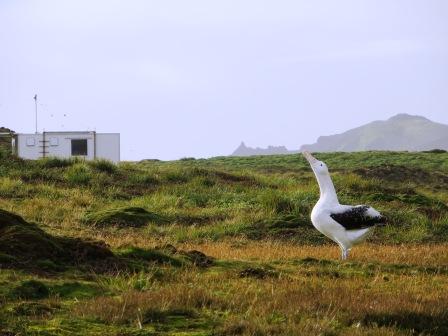On 21 December 2011 a Wandering Albatross Diomedea exulans died on sub-Antarctic Marion Island after becoming entangled with an aerial wire that had been erected at a field hut in April of that year (click here).
Following various discussions as how best to address the problem within the South African National Antarctic Programme, the two environmental officers present on the island in 2012/13 fixed bright yellow and red plastic lids from beverage containers onto the aerial wires at intervals with cable ties to act as visual deterrents.
Among the huts that have been fitted with these anti-collision devices are the three that have albatrosses breeding close by: Swartkop Point and Mixed Pickle Cove (Wandering Albatrosses) and Grey-headed Albatross Ridge (Grey-headed Albatrosses Thalassarche chrysostoma).

The Wanderer that died in 2012 was entangled with wire No. 4. This and wire No. 3 have now been moved 90° to behind the hut, out of the usual flight path marked with a white double-headed arrow
Photograph by Anton Feun
Additionally, in about March of this year the 2012/13 team radio technician moved two of the four wires of the aerial array at the Swartkop Point Hut through 90° to be closer to a small rise so that the wires would be less likely to be hit by Wanderers flying past at low altitude as they come into land at their nearby nests (see picture above).
No further reports of collisions or entanglements by Wandering Albatrosses in the last year have been reported at Swartkop Point, although on 24 September 2102 a Wandering Albatross flew into an aerial wire at Mixed Pickle Cove, but without apparently incurring any injury. This strike took place before the anti-collison devices were fitted in about November of last year.
Although nocturnal bird strikes on the wires are still regularly reported at the island’s eight coastal field huts, including at those fitted with lids, these have been mainly by burrowing petrels, such as the Blue Petrel Halobaena caerulea, which breeds in numbers close to the Swartkop Point Hut where the albatross died. ACAP-listed White-chinned Petrels Procellaria aequinoctialis have also collided with aerial wires at several of the huts, again without observed injury, perhaps due to the slack nature of the wires.

Brightly-coloured anti-collision devices move in the strong winds that are common on Marion Island
Photograph by John Cooper
Various other options to reduce the number of strikes are still being considered, for example only erecting the aerial wires when the huts are occupied and at the fixed times of daily radio calls to the island’s weather /research station.

With the aerial wires moved at Swartkop Point this bird now has a lower chance of becomng entangled following a collision
Photograph by Marienne de Villiers, April 2013
With thanks to Jacqueline Davis, Rory Meyer and Zandile Simama for their conservation efforts and Linda Clokie, Bruce Dyer and Anton Feun for information.
John Cooper, ACAP Information Officer & Marienne de Villiers, 9 May 2013

 English
English  Français
Français  Español
Español